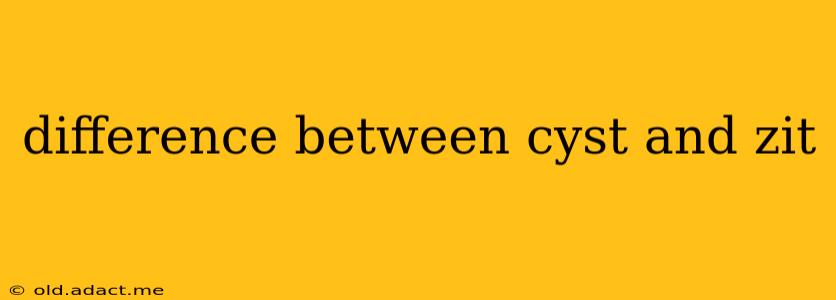Difference Between a Cyst and a Zit: Understanding Skin Lesions
Many people confuse cysts and zits (acne), as both can appear as bumps on the skin. However, they are vastly different in their formation, characteristics, and treatment. Understanding the key distinctions is crucial for proper diagnosis and treatment.
What is a Zit (Acne)?
A zit, or pimple, is a common skin lesion resulting from a blockage in a hair follicle. This blockage occurs when sebum (an oily substance produced by your skin), dead skin cells, and bacteria combine to clog the pore. This clog can manifest as a whitehead (closed comedone), a blackhead (open comedone), a papule (small, red bump), a pustule (pimple with pus), or a nodule (larger, deeper inflammation). Acne typically affects the face, chest, back, and shoulders.
What is a Cyst?
A cyst is a sac-like structure that forms beneath the skin's surface and is filled with fluid, semi-solid material, or air. Unlike acne, which is primarily caused by blocked pores, cysts develop from various factors including blocked glands, infections, or abnormal cell growth. Cysts can be found anywhere on the body, not just areas prone to acne. They can range in size from tiny to several centimeters in diameter.
What are the Key Differences Between a Cyst and a Zit?
Here's a table summarizing the key differences:
| Feature | Zit (Acne) | Cyst |
|---|---|---|
| Cause | Blocked hair follicle, sebum, bacteria, dead skin cells | Blocked gland, infection, abnormal cell growth |
| Location | Primarily face, chest, back, shoulders | Anywhere on the body |
| Appearance | Small to moderate bumps, may contain pus | Larger, often round bump, may be fluctuant (movable) |
| Pain | Can range from mild to significant pain | Can be painful, especially if inflamed |
| Depth | Usually superficial | Can be deep, extending below the skin surface |
| Duration | Typically resolves within days to weeks | Can persist for weeks, months, or even years |
| Treatment | Over-the-counter treatments, prescription medications | May require professional medical intervention |
How Can I Tell the Difference?
Differentiating between a cyst and a zit can be challenging, especially for those without medical training. However, some visual clues can help:
- Size and Depth: Cysts are generally larger and deeper than zits.
- Consistency: Cysts often feel firm and are more movable under the skin than pimples.
- Pain: While both can be painful, cyst pain tends to be more intense and persistent.
- Duration: Zits usually clear up relatively quickly, whereas cysts can last much longer.
What are the Treatments for Cysts and Zits?
Zits: Mild acne can often be treated with over-the-counter topical medications containing benzoyl peroxide or salicylic acid. More severe acne may require prescription medications such as retinoids, antibiotics, or oral isotretinoin.
Cysts: Cysts often require professional medical attention. Treatment options may include draining the cyst, injecting it with corticosteroids, or surgical removal. In some cases, antibiotics may be necessary to treat associated infection.
Disclaimer: This information is for educational purposes only and does not constitute medical advice. If you are concerned about a skin lesion, it's important to consult a dermatologist or healthcare professional for proper diagnosis and treatment.
Are cysts contagious?
Not all cysts are contagious. The contagiousness depends entirely on the cause of the cyst. Infectious cysts, caused by bacteria or viruses, can be contagious, often through direct contact with an infected area or through contaminated objects. However, many cysts arise from non-infectious causes like blocked glands or abnormal cell growth and are not contagious.
Can cysts go away on their own?
Some small, uncomplicated cysts might resolve on their own without intervention, but many will not. Larger cysts, painful cysts, or cysts that are infected are unlikely to heal spontaneously and often require medical treatment.
What causes cysts?
Cysts can result from several factors, including blocked ducts or glands, infections (bacterial or parasitic), or abnormal cell growth. Genetic predisposition also plays a role in the development of some types of cysts. The specific cause varies depending on the type and location of the cyst.
This detailed comparison should help you better understand the key differences between cysts and zits, enabling you to seek appropriate medical care when necessary. Remember, always consult a healthcare professional for accurate diagnosis and treatment.
